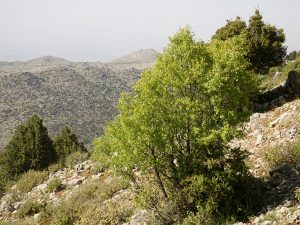
A tree bringing Montpellier to Mount Hermon – قيقب حرمون
- October 11, 2023
- 0
What brings Montpellier in Southern France to Mount Hermon in Lebanon? It is the Montpellier maple tree or Acer monspessulanum (in French: érable de Montpellier). This maple tree has travelled from west to east (and maybe in the opposite direction) and became distributed across the Mediterranean basin.
Maple seeds are winged, giving them an advantage to fly when wind blows, which provides them with an effective seed dispersal. Despite this ability to conquer new distant territories, it will take time (thousands years) for the species to cross the Mediterranean from one end to another. But in the process, when seeds are dispersed, they fall in new places with new environmental conditions, and new climate. Hence, the new born tree is obliged to adapt to the new conditions. Adaptation to longer dry periods, lower precipitations or higher evapotranspiration was faced by a reduction of leaf size. Those traits which would appear initially when conditions are harsh, become inherited and transmitted genetically from one generation of trees to another.

Along this travel, and those years, the Montpellier maple which thrives on the eastern Mediterranean has moved upwards in altitude to live in mountains where temperature is lower (while in Montpellier the same temperatures exist next to the sea). The leaves became smaller giving the species another name: Acer monspessulanum microphyllum (micro-leaves) or better Acer hermoneum, due to its frequent presence in Mount Hermon (Jabal el Sheikh) or in Arabic قيقب حرمون . This tree is also found in Syria, Jordan, and Turkey, while the Montpellier tree with wider leaves is found in countries with more humid conditions such as France and other western or central European countries.

In Lebanon the tree is distributed mainly between 900 and 2000m on both Mountain ranges, but more frequently in the drier conditions of the eastern slopes of Mount Lebanon (from Fisane in Hermel to Machghara), and the western slopes of Mount Hermon and Anti-Lebanon (from Chebaa to Aarsal), and the areas liking both ranges between Kfarmeshki and Al Rafid. It is hence found in most protected areas (Ehden, Tannourine, Jaj, Shouf, Yammouneh and Rashaya). It thrives on forest edges and open areas to avoid bigger trees, therefore its best companion is the juniper.

It is currently planted in few local nurseries for ornamental use or for reforestation. Maple tree is also pruned or cut for fuel wood, mostly by shepherds who have limited options for heating and cooking in high mountains.
The tree is small (5 to 12m height), with three lobed leaves turning red in autumn. Among the tree maple species that we have in Lebanon, it is the one with the smallest leaves and tree size, and the only one with the leaves turning red or purple red. Another hint to differentiate the three species is the angle of the seed wings. It is also the most drought tolerant, but we will tell the stories of the remaining maple species in other issues…
cover image: Oussama Abou Ibrahim
Article prepared by: Dr Jean Stephan











